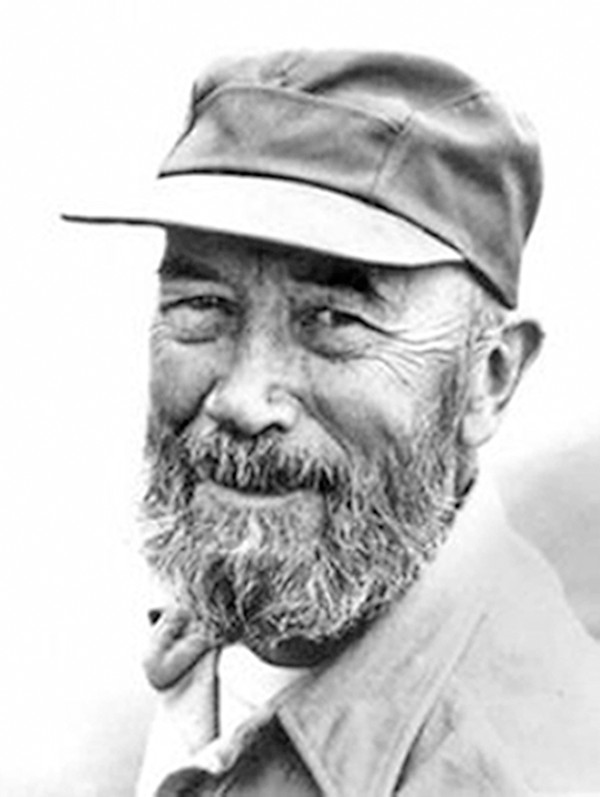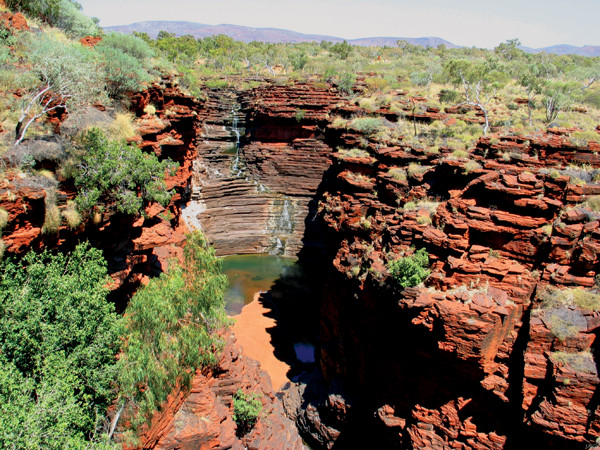
by Julia Rosen Monday, December 15, 2014

Public domain.
Banded iron formations (BIFs) represent some of the earliest, and most controversial, evidence that the early Earth was devoid of oxygen. These deposits — consisting of thin layers of iron, primarily magnetite and hematite, interspersed with chert, shale and quartz — were recognized for their economic value in the mid-1800s. But it wasn’t until the late 1960s when Preston Cloud, the eminent 20th-century American geologist, focused his vast and wandering intellect on their origins that they assumed their prominent role in the revelation of early Earth history.
Preston Ercelle Cloud Jr. was born in West Upton, Mass., on Sept. 26, 1912, the son of an engineer-draftsman father and genealogist mother. He joined the Navy before starting night school at George Washington University in Washington, D.C., where he first became interested in geology. He went on to complete his doctorate at Yale in a staggering three years and then to distinguished positions at the U.S. Geological Survey, UCLA, and finally, the University of California at Santa Barbara, where he spent the latter decades of his life.
Cloud did not grow interested in the early Earth until 30 years into his long and fascinating career, after spending decades building a highly respected and populous paleontology group at the U.S. Geological Survey in Washington, D.C., establishing himself as an expert in carbonate stratigraphy and pioneering the field of marine geology. Cloud unapologetically described himself as “one who always had trouble confining his interests or finding good reason why he should” — one for whom “it was only natural to become a geologist.”
By the late 1960s, BIFs were already well-studied features of the Archean Earth thanks to the steel industry’s demand for iron ore. Deposits had been documented in Canada and the American Midwest, Australia, Greenland and South Africa, yet none appeared to be younger than 1.9 billion years old.

Beatriz Ribeiro da Luz, U.S. Geological Survey.
In a seminal 1968 paper in Science, Cloud noted that BIFs must have formed in anoxic oceans because oxidized iron is stubbornly insoluble. The abundance of BIF deposits implied the existence of a soluble, reduced, ionic form of iron that ocean currents could transport great distances from its sources — weathered continental rock and hydrothermal vents — to the sites of deposition. Cloud argued that rising atmospheric oxygen concentrations about 2 billion years ago explained the absence of younger BIF deposits, defining for the first time this important transition in Earth history.
However, anoxic oceans do not offer an obvious mechanism for how BIFs precipitated — a process that almost certainly required oxygen. Cloud suggested that the evolution of the first photosynthetic autotrophs, probably early forms of blue-green algae, could have produced small amounts of free oxygen that reacted with reduced iron to precipitate magnetite and hematite.
This made perfect sense to Cloud because it solved another nagging riddle of early biology: In the absence of complex enzymes that convert free oxygen (which forms dangerous radicals) into nontoxic compounds within biological cells, the first photosynthetic organisms would have poisoned themselves with the oxygen they produced. Reduced iron may have acted as an oxygen receptor, binding the harmful molecules, allowing photosynthesis to continue, and perhaps even explaining the layering of BIFs through periodic iron limitation.
Cloud extended this logic to explain the delayed buildup of oxygen in the oceans and atmosphere until the disappearance of BIFs about 1.9 billion years ago. He argued that the evolution of oxygen-binding enzymes at this time freed organisms from the constraints of iron availability, finally allowing the gas to accumulate on Earth.
Cloud’s theory remains a topic of heated debate in Archean geochemistry. Some scientists suggest alternative methods of forming BIFs that don’t require biological activity, and many still struggle to explain BIFs’ vast spatial extent, uncannily regular layering, and whether they formed in the photic zone.
However, the Cloud Model of the early Earth, as it is often called, was strengthened by Cloud’s observations that the abrupt termination of BIF formation 1.9 billion years ago coincided with other important geochemical indicators. Archean deposits of detrital uraninite and pyrite — which, in contrast to iron, cannot survive in oxic environments — ceased to form after this time, while terrestrial “redbeds” made their first appearance. These widespread rust-colored soil horizons contain oxidized iron, indicating that oxygen must have constituted an appreciable fraction of Earth’s atmosphere by this time.
Despite the debate surrounding the origin of BIFs, several disparate lines of evidence now make a compelling argument that Cloud closely identified the timing of what we now call the Great Oxidation Event. The rise in atmospheric oxygen is now widely accepted to have begun between 2.5 billion and 2.2 billion years ago based on compelling geochemical evidence from sulfur isotopes, a discovery published in 2000 — a decade after Cloud’s death and more than 30 years after he first investigated the origins of atmospheric oxygen.
Throughout the rest of his career, Cloud continued to build his intertwined narrative of oxygen and life through the Proterozoic. He saw the lack of evidence for complex life prior to the Ediacaran 640 million years ago not as a failure of the incomplete fossil record — the prevailing explanation at the time— but as proof that life diversified in rapid explosions fueled by changing environmental conditions. The rise of metazoa (complex life) that defined the Ediacaran period, in Cloud’s view, must have occurred when sufficient oxygen accumulated to support complex life forms. The metabolic demands of larger organisms would have required higher oxygen concentrations to survive, especially as they likely lacked circulatory systems.
Cloud never succeeded in convincing his peers to revise the lower boundary of the Phanerozoic to include these first complex life forms (a cause he championed passionately), but time has borne out his suspicion that the diversification of metazoan life coincided with the last major increase in atmospheric oxygen concentrations, when oxygen levels reached approximately modern values. Although no conclusive evidence existed in his day, the geologic record of charcoal, which requires oxygen to form, now places the rise of oxygen between 800 million and 600 million years ago, coincident with Ediacaran diversification.
The more Cloud learned of the early planet, the more he came to appreciate the uniqueness of Earth and the serendipity of human existence. He grew acutely aware of the fragility of life in a vast, lonely universe, and the finite nature of the planet’s reserves, a view reflected in the title of his last book, “Oasis in Space,” which he published in 1988 synthesizing his life’s work. He became one of the earliest advocates for sustainability, chairing committees for the National Academies of Science on resource and energy availability and even addressing climate change, though he did not live to witness the scientific consensus that later emerged on the threat it posed.
Preston Cloud — paleontologist, stratigrapher, geochemist and conservationist — would have turned 101 this month. The meandering arc of his curiosity transgressed disciplines and geologic eras, allowing him to synthesize disparate strands of evidence into insightful conclusions about the Earth’s past, present and future. Today, there are few disciplines of earth science that cannot count among their fundamental tenets the contributions of Preston Cloud.
© 2008-2021. All rights reserved. Any copying, redistribution or retransmission of any of the contents of this service without the expressed written permission of the American Geosciences Institute is expressly prohibited. Click here for all copyright requests.